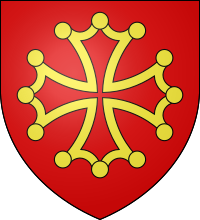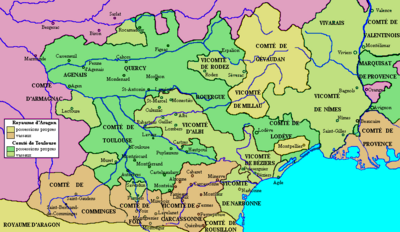Toulouse county

The county of Toulouse around its capital Toulouse was a medieval feudal territory in the south of what is now France . In terms of area, its territory roughly comprised the present-day departments of Haute-Garonne , Tarn and Tarn-et-Garonne .
history
founding
The county of Toulouse was founded at the end of the 8th century by the Frankish king Charlemagne , after he brought the region of Languedoc , corresponding to today's south-east France, under his rule in several campaigns against the Moors . To administer the region, Karl installed his followers as counts in the most important cities, who were supposed to rule the country and defend it from attacks by the Moors. The Counts of Toulouse were subordinate to the Carolingian part of Aquitaine .
Dispute for supremacy
After the death of Charlemagne and the associated collapse of the royal central power, order in the so-called Midi also collapsed , and the counts of the region fought each other for supremacy. The families of the Gellones (Wilhelmiden) , who also fought for rule over all of Aquitaine, and the Raimundines , who were at home in the Rouergue region, competed for Toulouse . In addition, several usurpers appeared in the power struggle. In 849 and 864, King Charles the Bald confirmed the Raimundines as Count of Toulouse. This family then prevailed permanently in Toulouse, especially after the Gellones were defeated in the battle for Aquitaine against the Counts of Poitou . The Tolosan counts were among the most powerful princes of the south due to the accumulation of other counties (including Rouergue, Quercy , Albi , Béziers , Narbonne , Nîmes ) and as liege lords of other counts (including Foix , Carcassonne , Razès ) and were strong enough to maintain themselves to separate from the supremacy of Aquitaine and henceforth to form its own principality.
Self-reliance
When the last king of the Carolingian dynasty died in 987 and the Capetians ascended the throne with Hugo Capet , the Counts of Toulouse refused to recognize the new ruling house. Because of their weakness, the early Capetian kings could not do anything about it. This made Toulouse a de facto sovereign principality, whose counts claimed supremacy over all the other princes of Languedoc . The basis for this was the inherited dignity of a Duke of Narbonne , which went back to the old Margraviate of Septimanien / Gothien . In the 11th and 12th centuries, the counts of Toulouse were therefore in competition with the counts of Barcelona and kings of Aragón , who were pursuing the same goal.
Crusades
From the end of the 11th century, Raymond IV of Toulouse and his descendants made a name for themselves during the Crusades as Counts of Tripoli in what is now Lebanon . The county passed to the princes of Antioch by bequest or inheritance in 1187 .
Peak of power
With his estate around the city of Toulouse, which stretched from Agen along almost the entire Garonne and also encompassed the entire course of the Lot River in the north, and the Languedoc as a fief (with a focus on Avignon ), the Count of Toulouse was in the 11th century of power only behind the kings of France on a par with the dukes of Burgundy and Aquitaine . Towards the end of the century a hereditary hostility developed towards Aquitaine, which developed into a serious threat for Toulouse in the 12th century after Aquitaine was integrated into the powerful family conglomerate of the Plantagenets ( Angevin Empire ).
Albigensians
In the middle of the 12th century the county became a center of the Cathar heretical sect and the counts got involved in the devastating Albigensian Crusade from 1209 to 1229 . They were fought by Simon IV. De Montfort , who wanted to create his own principality in Toulouse. Montfort's rule over Toulouse was established in 1215 at the fourth Lateran Council by a papal fief, but was never accepted by the legitimate count. By 1224 the counts succeeded in driving out the crusaders, but the country was then so economically and militarily weakened that it could no longer oppose the following crusade of King Louis VIII of France in 1226 .
Connection to France
In the Treaty of Meaux-Paris in 1229, Toulouse submitted to the Crown of France. In the same year Joan the Pious , the only heiress of the county, with Alfons of Poitiers , brother of the French King Louis IX. engaged - both were 9 years old at the time. In 1241 the marriage between the two took place; Since the marriage remained childless, after their death (1271) the county fell entirely to the crown by inheritance, but retained special rights until 1779.
The Counts of Toulouse
| Surname | Reign | relationship | Remarks |
|---|---|---|---|
| Choir | 778-790 | ||
| William I of Gellone | 790-806 | Gellones | |
| Beggo I. | 806-816 | Gerhardiner / Matfriede | |
| Berengar the Wise | 816-835 | Unruochinger | |
| Bernhard I of Septimania | 835-844 | Son of Wilhelm von Gellone | Gellones |
| Wilhelm II of Septimania | 844-849 | Son of his predecessor | Gellones |
| Raimundiner (Toulouse House) | |||
| Fredelo | 849-852 | ||
| Raimund I. | 852-863 | Brother of his predecessor | |
| Humfried of Gothien | 863-864 | usurper | |
| Bernhard II. | 864-872 | Son of Raymond I. | |
| Bernhard III. Plantapilosa | 872-885 | Brother of Wilhelm II. | usurper |
| Odo | 885-919 | Brother of Bernhard II. | |
| Raymond II. | 919-923 | Son of his predecessor | |
| Raimund III. Pons | 923-960 | Son of his predecessor | |
| William III. Taillefer | 960-1037 | Son of his predecessor | |
| Pons | 1037-1061 | Son of his predecessor | |
| William IV | 1061-1094 | Son of his predecessor | |
| Raymond IV of Saint-Gilles | 1094-1105 | Brother of his predecessor | First crusade |
| Bertrand | 1105-1108 | Son of his predecessor | |
| Alfons Jordan | 1108-1148 | Brother of his predecessor | |
| Raimund V. | 1148-1194 | Son of his predecessor | |
| Raymond VI. | 1194-1222 | Son of his predecessor |
Albigensian Crusade Counter Count: Simon IV. De Montfort |
| Raymond VII. | 1222-1249 | Son of his predecessor | Albigensian Crusade Counter Count: Amaury de Montfort |
| Johanna | 1249-1271 | Daughter of her predecessor | |
| Capetians | |||
| Alfonso of Poitiers | 1249-1271 | Husband of Johanna | |
| Association with the Crown Domain | |||
- In 1681, King Louis XIV of France awarded his illegitimate son Louis Alexandre the title of "Comte de Toulouse" on the occasion of his legitimation.

